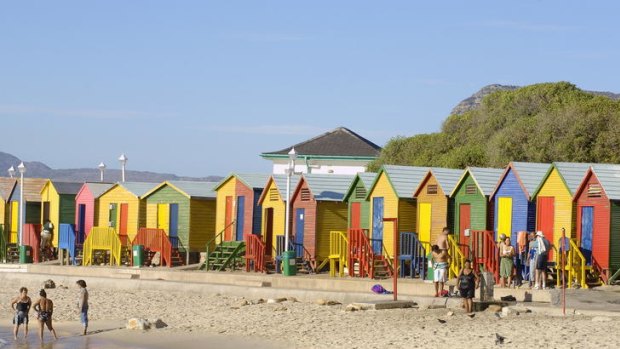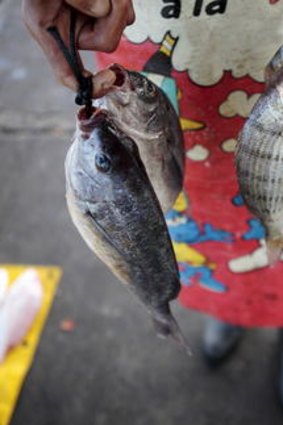
Easy does it ... beach huts line the shore.Credit: Getty Images
Alison Stewart explores a nook that Cape Town locals would like to keep quiet.
THE people of Cape Town love Kalk Bay, a special place they tend to keep for themselves. They love the picturesque sheltered harbour with its colourful wooden fishing boats, the daily fish market, the trendy boutiques, quirky antique shops, art galleries, restaurants, coffee shops and bakeries.
They love the views in whale season, the historic houses and cobbled laneways that wind up the hill. Kalk is Cape Town's equivalent of San Francisco's Sausalito, only without the tourists. That's great for locals but in the spirit of sharing, those on the city's well-trodden tourist paths might like to experience this road less travelled.
Apart from the excellent food and bohemian atmosphere, there's something inspirational about the light in this gorgeous little fishing village (actually a Cape Town suburb) just 30 minutes from the city centre, squeezed between False Bay and the reaches of the Table Mountain National Park.
It's no coincidence that artists and writers flock here. The craggy mountain that dominates this western peninsula stretch of the False Bay coast looms behind the village and somehow concentrates the ocean light. On sunny days, the blue is almost luminous but wet days yield their own quality.
Kalk Bay is all about the sea. It's a prime spot for whale spotting during the June to November mating and calving season, when an array of whales including southern right, humpback, blue, Bryde's, beluga, minke and sperm swim lazily into the calm inlets. They often come within metres of the shore to stay safe from the great whites that hunt off Seal Island further out in the bay.

Catch of bream from the bay.Credit: Getty Images
There are even more majestic views from Boyes Drive, which cuts into the side of the Kalk Bay mountains above the village. These mountains provide a wonderful series of marked paths from which energetic walkers and nature lovers can see native flora.
Intrepid explorers can scramble up to the 100 or more caves that honeycomb the mountain, with names such as Rest-a-Bit, Light and Gloom, Six Moles, Boomslang, Moss and Diamonds, Drip-Drop, Noonday Rest, Me Too, Mirth Parlour, Creepy Corridor, Free Drinks Saloon and Ronan's Well after the Walter Scott novel St Ronan's Well. These sandstone structures are unusual because large cave systems are not often found in this type of chemically non-reactive rock.
Most visitors, though, will stick to sea level, meandering from gallery to bakery to coffee shop, just revelling in Kalk Bay. What is it about this place? The author whose novel Trespass (2009) was nominated for the Commonwealth Prize in Africa, Dawn Garisch, lives there because of the "fabulous restaurants, live music, theatre, art galleries and ... real community".
I would argue that Cape Town visitors might enjoy staying on warmer False Bay - rather than the Table Bay side of the city - at one of the seaside bays that run down to Cape Point. There's St James, Kalk Bay, Clovelly, Fish Hoek, Simon's Town, Boulders or Seaforth - all prime viewing spots for whales and the famous 3000-strong African penguin colony at Boulders Beach. But even if you're staying in the city, the train will take you right to the centre of Kalk Bay. Some might say this is the best way to arrive. From Muizenberg, the line hits the coast with the train only metres from the waves. I have fond childhood memories of craning to see the first glimpse of Muizenberg "Corner" where surfers rode the long rollers. It's then only a short hop to St James and Kalk Bay. Otherwise, stay nearby and you can easily walk from one end of Kalk Bay to the other. Rent a car for trips further afield.
Before the railway arrived in 1883, Kalk Bay was a healthy holiday spot for well-to-do English visitors. Cecil John Rhodes owned a thatched holiday cottage, now a museum. If you're staying in Kalk Bay, you might like an early swim at neighbouring St James, which has grand "millionaire's mile" houses and bright Victorian bathing boxes.
Kalk Bay (pronounced "cork") was established in the 17th century as a community of lime burners ("kalk" means lime in Dutch), who extracted lime from seashell deposits. Many of the Cape's older homes owed their white walls to Kalk Bay lime. The harbour is still the focal point and one of South Africa's last working harbours.
The fishing boats return at midday and all hell breaks loose as people join the "fish auction" for whatever's in season - geelbek, kabeljou and red roman - but most favoured of all, the long silver snoek, is caught by the traditional hand-line method. The snoek season peaks midyear. Catch your own (dodging the seals that leap up for scraps) and braai (barbecue) it for dinner. Smoked snoek is a delicacy.
Above the Olympia Cafe & Deli (see box) is Kalk Bay Modern, an airy gallery space featuring local artists and designers. Or you could spend hours inside George Curtis's Quagga Rare Books & Art, which stocks wonderful antiquarian books, maps, watercolours, paintings and other collector's items.
Kalk Bay Books, the brainchild of former magazine editor Ann Donald, is in the historic stone "Klipkantientjie" building, once a sailors' pub, and is lined with floor-to-ceiling bookshelves.
There is any number of unusual, atmospheric interior and fashion design shops, such as Mystic Rose, stocked with local designer Jacqueline Partridge's vintage-inspired creations. Finally, wave-obsessed visitors might warm to the fact that this is the home of the "Kalk Bay Reef", renowned for its heavy barrels and best surfed on a big south-easterly swell or a north-wester. Beware the shallow reef, otherwise Kalk Bay may leave its mark on you in a more indelible way.
The writer was a guest of South African Airways.
Trip notes
Getting there
South African Airways has return flights from Sydney to Cape Town via Johannesburg from $2269.
Staying there
St James Manor or Seaforth House, elegant with lovely bay views. St James Manor doubles from 2280 rand ($277) or Seaforth House from 2150 rand, including breakfast, alcohol, laundry, internet and parking. +27 21 788 4543, rovos.com/st-james.html.
The Milestone cottage. Self-catering. Stay a little further afield (12 kilometres) at this historic wooden cottage, slap-bang on False Bay. From 1350 rand a night, minimum four nights' stay, capestay.co.za/milestone.
More information
Sign up for the Traveller Deals newsletter
Get exclusive travel deals delivered straight to your inbox. Sign up now.